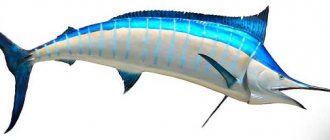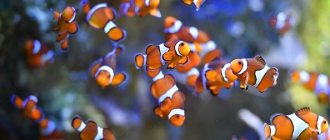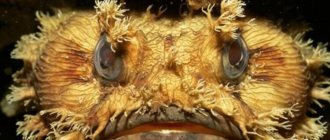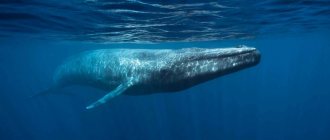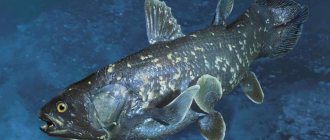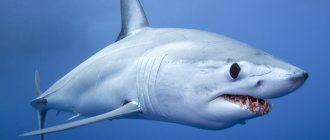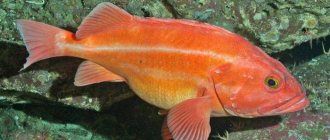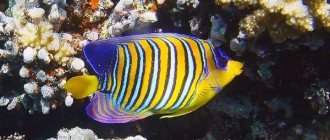Seas and oceans occupy more than half the area of our planet, but they are still shrouded in mysteries for humanity. We strive to conquer space and are looking for extraterrestrial civilizations, but at the same time, only 5% of the world's oceans have been explored by humans. But this data is enough to be horrified by what creatures live deep underwater, where sunlight does not penetrate.
Common chauliod (Chauliodus sloani)
The Chauliod family includes 6 species of deep-sea fish, but the most common of them is the common hauliod. These fish live in almost all waters of the world's oceans, with the only exceptions being the cold waters of the northern seas and the Arctic Ocean.
Chauliodas got their name from the Greek words “chaulios” - open mouth, and “odous” - tooth. Indeed, these relatively small fish (about 30 cm in length) have teeth that can grow up to 5 centimeters, which is why their mouth never closes, creating a creepy grin. Sometimes these fish are called sea vipers.
Howliods live at depths from 100 to 4000 meters. At night they prefer to rise closer to the surface of the water, and during the day they descend into the very abyss of the ocean. Thus, during the day, fish make huge migrations of several kilometers. With the help of special photophores located on the hauliod's body, they can communicate with each other in the dark.
On the dorsal fin of the viper fish there is one large photophore, with which it lures its prey directly to its mouth. After which, with a sharp bite of needle-sharp teeth, the hauliods paralyze the prey, leaving it no chance of salvation. The diet mainly includes small fish and crustaceans. According to unreliable data, some individuals of hauliods can live up to 30 years or more.
Sea creatures
Bobbit's polychaete worm
The Australian purple polychaete worm, also known as the Bobbitt worm, can grow up to 3 meters in length.
.
It hunts its prey in the most diabolical way, burrowing into the seabed, leaving a small part of its body on the surface and waiting for the victim. Using its antennae, the worm senses passing prey, quickly captures it with its strong, muscular throat, and splits the fish in two.
.
Flower cap jellyfish
These jellyfish, with beautiful multi-colored tentacles emanating from a translucent umbrella, feed on small fish and sometimes each other.
They can increase or decrease in size
depending on food supplies.
Rag seahorse
These slow-moving fish are related to seahorses. They rely primarily on their seaweed-like appendages for camouflage and defense against predators.
.
Siphonophores
Siphonophores are colonies of animals
, consisting of individual representatives called zooids, connected by a common trunk. Such a colony can reach several meters in length.
Crown jellyfish
This atoll jellyfish or crown jellyfish is very similar to a UFO, because, like most jellyfish, it does not have a digestive, respiratory, circulatory or central nervous system.
It lives at a depth of 1000 - 4000 meters
where sunlight does not penetrate.
When scared, this jellyfish turns on bioluminescent blue lights
that spin like flashing lights on a police car.
Pike blenny
These fish usually hide inside shells on the seabed. They are small (up to 30 cm) but fierce fish with a large mouth and aggressive behavior.
.
When two pike blennies fight for territory, they press their widened mouths against each other as if in a kiss. This helps them determine who is bigger.
Glass squid
There are about 60 species of glass squid
or crachniid. Most of them, as the name suggests, are transparent, which helps them camouflage.
Pteropods
Pteropods are small sea snails
which swim in the water on two wing-shaped legs. They are born male, but become female when they reach a large size.
Long-horned sabertooth (Anoplogaster cornuta)
The longhorned sabertooth is another fearsome deep-sea predatory fish that lives in all four oceans. Although the saber tooth looks like a monster, it grows to a very modest size (about 15 centimeters in length). The head of the fish with a large mouth occupies almost half the length of the body.
The long-horned sabertooth got its name due to its long and sharp lower fangs, which are the largest in relation to body length among all fish known to science. The terrifying appearance of the sabertooth has earned it the unofficial name “monster fish.”
Adults can vary in color from dark brown to black. The younger representatives look completely different. They are light gray in color and have long spines on their heads. The sabertooth is one of the deepest-sea fish in the world; in rare cases, they descend to depths of 5 kilometers or more. The pressure at these depths is enormous, and the water temperature is about zero. There is catastrophically little food here, so these predators hunt for the first thing that gets in their way.
Black Crookshanks (Chiasmodon niger)
Found in tropical and subtropical waters of all oceans, the Black Crookshank is known for its ability to swallow prey much larger than itself. The stomach and walls have the ability to stretch very much, which allows the fish to hunt for larger prey without any problems. Despite such predatory habits, the body length of this fish rarely exceeds 15 centimeters.
Black Crookshanks (Chiasmodon niger)
Tags: depths, sea animals, ocean, fish
Rate this article:
(votes: 77 , rating: 4.78 out of 5)
Dragonfish (Grammatostomias flagellibarba)
The size of the deep-sea dragon fish absolutely does not fit with its ferocity. These predators, which reach a length of no more than 15 centimeters, can eat prey two or even three times its size. Dragon fish live in tropical zones of the World Ocean at depths of up to 2000 meters. The fish has a large head and a mouth equipped with many sharp teeth. Like the Howlyod, the dragonfish has its own bait for prey, which is a long whisker with a photophore at the end, located on the fish's chin. The hunting principle is the same as for all deep-sea individuals. Using a photophore, the predator lures the victim to the closest possible distance, and then with a sharp movement inflicts a fatal bite.
A new species of reservoir inhabitants?
Stuart Fraser showed photographs of the amazing creature to Paul Kast, director of the National Marine Aquarium. After studying the photographs, he determined that this creature was none other than Salpa Maggiore - a transparent fish. This species is similar in appearance to jellyfish, but nevertheless has a close relationship with marine vertebrates.
Salpa Maggiore is a transparent fish (see photo below). However, it has a heart and gills. In addition, there are special filters inside this fish. They pass water through its body, collecting food in the form of phytoplankton and algae.
View gallery
Salpa Maggiore is a transparent fish that travels in large groups. The peculiarity of this species is that individuals of this creature have no gender. They are able to independently produce offspring, forming massive schools.
Salpa Maggiore is a transparent fish (the photo confirms its unusual appearance), and it looks like a creature from a horror movie. However, you shouldn't be afraid of her. This is an absolutely harmless creature that feeds on planton. The transparent body is only a camouflage that can protect the fish from attacks by sea predators, which, like it, live in the surface layers of water.
Very little information has been collected about the Salpa Maggiore fish. Scientists attribute it to one of the subspecies of salsa, numbering about thirty species. In addition, these marine invertebrates are known to prefer to live in the cold waters of the Southern Ocean.
The transparent fish Salpa Maggiore has a barrel-shaped shape. It moves through water by pumping fluid through its body. The jelly body of the fish is covered with transparent scales, through which the annular muscles and intestines are visible. On the surface of the unusual creature you can see two siphon holes. One of them is oral, leading into the large pharynx, and the second is cloacal. The openings of the siphons are located at opposite ends of the transparent body of the fish. On the ventral side of the sea animal is the heart.
Deep sea anglerfish (Lophius piscatorius)
The deep-sea anglerfish is rightfully the ugliest fish in existence. There are about 200 species of anglerfish, some of which can grow up to 1.5 meters and weigh 30 kilograms. Because of its creepy appearance and bad character, this fish was nicknamed the monkfish. Deep-sea anglerfish live everywhere at depths from 500 to 3000 meters. The fish has a dark brown color, a large flat head with many spines. The devil's huge mouth is studded with sharp and long teeth curved inward.
Deep-sea anglerfish have pronounced sexual dimorphism. Females are tens of times larger than males and are predators. Females have a rod with a fluorescent appendage at the end to attract fish. Anglerfish spend most of their time on the seabed, burrowing into sand and silt. Due to its huge mouth, this fish can completely swallow prey that is twice its size. That is, hypothetically, a large individual anglerfish could eat a person; Fortunately, there have never been such cases in history.
Predators of the sea
Among ocean fish, sharks are far from the only predators. There are many other aggressive representatives.
Moray eel likes to hide. To do this, she uses caves, coral reefs and thickets of vegetation. The body is quite elongated; with a length of three meters, its thickness is only 30 centimeters. It has a strong jaw, which it actively uses when hunting. Easily camouflaged and attacks from ambush, holds prey tightly with its mouth, uses its tail to hold or tear the victim. With poor eyesight, he has an excellent sense of smell.
One of the dangerous sea predators is the moray eel, which tears its prey with its long tail.
Barracudas are somewhat similar to giant three-meter pikes. They are dangerous to human health and can bite off limbs and cause other injuries. They attack suddenly and indiscriminately, including eating poisonous food. Because of this, their meat is toxic and is not used in gastronomy.
The swordfish is larger in size than many sharks - three meters long and almost half a ton of mass. The most dangerous part of the body is the long bone growth on the upper jaw.
The danger of this fish is the growth on the upper jaw that resembles a sword.
The European fishing rod is also called the devil. This is due to its extremely unattractive appearance. Its wide mouth is shaped like a crescent moon, its lower jaw is extended, and its eyes are located close to the middle of its head. On the long fin above the upper jaw, bacteria actively multiply and attract fish. If the bait does not work, the anglerfish can rise up and swallow whole a bird that has landed on the surface of the water.
Tuna is a predator that prefers to gather in schools. Its four-meter body can weigh half a ton, but the fish can swim at a speed of 90 kilometers per hour. Tuna is actively used in gastronomy; the French even call it sea veal.
Pelamida also has a silver color, but is much smaller in size. It is no longer than 85 centimeters and weighs no more than 7 kilograms. There are faint stripes on the back that have a blue tint. The fish gather in schools and hunt for sardines and anchovies.
Bagworm (Saccopharyngiformes)
Probably the strangest inhabitant of the deep sea can be called the bagmouth or, as it is also called, the pelican-shaped largemouth. Due to its abnormally huge mouth with a bag and a tiny skull in relation to the length of the body, the bagmouth looks more like some kind of alien creature. Some individuals can reach two meters in length.
In fact, bagmouths belong to the class of ray-finned fish, but these monsters do not have too many similarities with the cute fish that live in warm sea backwaters. Scientists believe that the appearance of these creatures changed many thousands of years ago due to their deep-sea lifestyle. Bagmouths have no gill rays, ribs, scales or fins, and the body is oblong with a luminous appendage on the tail. If it were not for the large mouth, the bagmouth could easily be confused with an eel.
Bagworms live at depths from 2000 to 5000 meters in three world oceans, except the Arctic Ocean. Since there is very little food at such depths, bagmouths have adapted to long breaks in eating, which can last more than one month. These fish feed on crustaceans and other deep-sea brethren, mainly swallowing their prey whole.
Barrel Eye
This inhabitant of the deep sea lives off the eastern coast of Russia. A distinctive feature is a transparent head, inside of which bright green eyes are hidden. Thus, the organ of vision is reliably protected from damage. The fish's eyes are shaped like cylinders and are directed vertically upward, tracking prey. Once the target is identified, the barrel eye makes a dash, moving upward. In this case, the muscles turn the eyes to a horizontal position, and the prey remains in the field of vision.
Giant squid (Architeuthis dux)
The elusive giant squid, known to science as Architeuthis dux, is the world's largest mollusc and is thought to reach a length of 18 meters and weigh half a ton. To date, a live giant squid has never been captured by humans. Until 2004, there were no documented cases of encountering a living giant squid, and the general idea of these mysterious creatures was formed only from the remains washed ashore or caught in fishermen’s nets. Architeuthis live at depths of up to 1 kilometer in all oceans. In addition to their gigantic size, these creatures have the largest eyes among living creatures (up to 30 centimeters in diameter).
So in 1887, the largest specimen in history, 17.4 meters long, washed up on the shores of New Zealand. In the next century, only two large dead representatives of the giant squid were discovered - 9.2 and 8.6 meters. In 2006, Japanese scientist Tsunami Kubodera managed to capture on camera a living female 7 meters long in her natural habitat at a depth of 600 meters. The squid was lured to the surface by a small bait squid, but an attempt to bring a live specimen on board the vessel was unsuccessful - the squid died from multiple injuries.
Giant squids are dangerous predators, and their only natural enemy is adult sperm whales. There are at least two described cases of fight between squid and sperm whale. In the first, the sperm whale won, but soon died, suffocated by the giant tentacles of the mollusk. The second fight took place off the coast of South Africa, then a giant squid fought with a baby sperm whale, and after an hour and a half fight, it still killed the whale.
Giant isopod (Bathynomus giganteus)
The giant isopod, known to science as Bathynomus giganteus, is the largest species of crustacean. The average size of a deep-sea isopod ranges from 30 centimeters, but the largest recorded specimen weighed 2 kilograms and was 75 centimeters long. In appearance, giant isopods are similar to woodlice, and like the giant squid, they are a consequence of deep-sea gigantism. These crayfish live at a depth of 200 to 2500 meters, preferring to bury themselves in silt.
The body of these creepy creatures is covered with hard plates that act as a shell. In case of danger, crayfish can curl into a ball and become inaccessible to predators. By the way, isopods are also predators and can feast on a few small deep-sea fish and sea cucumbers. Powerful jaws and durable armor make the isopod a dangerous opponent. Although giant crayfish love to feast on live food, they often have to eat the remains of shark prey that fall from the upper layers of the ocean.
Latimeria chalumnae
The coelacanth, or coelacanth, is a large deep-sea fish whose discovery in 1938 became one of the most important zoological discoveries of the 20th century. Despite its unattractive appearance, this fish is notable for the fact that for 400 million years it has not changed its appearance and body structure. In fact, this unique relict fish is one of the oldest living creatures on planet Earth, which existed long before the appearance of dinosaurs.
Coelacanth lives at a depth of up to 700 meters in the waters of the Indian Ocean. The length of the fish can reach 1.8 meters and weigh more than 100 kilograms, and the body has a beautiful blue tint. Since coelacanth is very slow, it prefers to hunt at great depths, where there is no competition with faster predators. These fish can swim backwards or belly up. Despite the fact that the meat of the coelcanth is inedible, it is often the target of poaching among local residents. Currently, the ancient fish is in danger of extinction.
Marine herbivores
Zebrafish fish has an interesting beautiful color. The part of the snout from the mouth to the eyes is decorated with small black patterns resembling freckles. From the eye to the caudal fin there is a black stripe, which is divided into two in the middle and combined again. The caudal fin is yellow but has a black edge.
There is a yellow stripe along the edge of the lateral fins, and a black stripe along the dorsal and ventral fins. The body is colored a pleasant shade of blue. This fish is quite small and is used in aquarium keeping, as it can be kept at home. In nature it is found both in small groups and alone.
The clown fish lives on a poisonous plant, escapes from predators and takes care of clean water around its saviorClownfish live in symbiosis with anemones, poisonous sea anemones. The body has an interesting color: on a bright orange background there are three white stripes, the transition parts are black. The fish are immune to the poisonous secretions of anemones. In nature, they hide in them from predators. When the school is not threatened, the fish swim actively and increase the flow of water, which brings food to the sea anemones. The fish is small, only 10-18 centimeters in length.
The pajama wrasse is a very fastidious fish with interesting colors. An aggressive attitude towards relatives from the same family is normal for her. He loves to terrorize his neighbors, harming them psychologically and physically. It feeds on algae and gets along well in a marine aquarium. They should be placed in a spacious container, where there is both free space for swimming and shelter. You can feed it with plant foods.
https://youtube.com/watch?v=AZaRQGj9bKE
Goblin shark (Mitsukurina owstoni)
The deep sea goblin shark, or goblin shark as it is also called, is the most poorly studied shark to date. This species lives in the Atlantic and Indian Oceans at depths of up to 1300 meters. The largest specimen was 3.8 meters long and weighed about 200 kilograms.
The goblin shark got its name due to its eerie appearance. Mitsekurina has movable jaws that move outward when bitten. The goblin shark was first accidentally caught by fishermen in 1898, and since then 40 more specimens of this fish have been caught.
Habitat and food
The deep-sea anglerfish lives in the waters of the World Ocean. The fish is adapted to live at depths of up to 3 kilometers. The anglerfish is especially common in the Atlantic Ocean, from the coast of Iceland to the Sea of Guinea, preferring cool waters.
Females hunt other deep-sea fish - gonostomidae, chauliodae, melamphae, and also feed on crustaceans and sometimes cephalopods.
The hunting process is as follows. The anglerfish lies on the bottom, hidden in the mud and algae. He turns on the glow of the eski and twitches it so that it looks like the movement of a small fish. To catch prey, the female patiently waits for it to swim to her. It pulls small prey into itself, sucking it in along with the water. It takes a few milliseconds to swallow a curious fish. Sometimes, using its developed pectoral fins or releasing jets of water through its gills, the anglerfish can jump forward, attacking prey.
The anglerfish is an extremely voracious fish; it can attack prey that is three times its size. Although the fish's stomach stretches to impressive sizes, such a meal ends in death for the fish. Since her teeth are curved inward, she cannot spit out her prey and gags.
Monkfish hunting methods are quite extraordinary
There have been cases where a species related to the anglerfish, monkfish, has swallowed seabirds with the same outcome. As a rule, the monkfish floats to the top when it eats intensively after spawning. At such moments, he can attack a person.
Males have a modest diet; they feed on small organisms. Up to a certain point, their food consists of copepods and bristlejaws, until the males begin to parasitize.
Hell Vampire (Vampyroteuthis infernalis)
Another relict representative of the sea abyss is a one-of-a-kind cephalopod-detritus feeder, which has an external resemblance to both a squid and an octopus. The hellish vampire got its unusual name thanks to its red body and eyes, which, however, depending on the lighting, can be blue. Despite their terrifying appearance, these strange creatures grow to only 30 centimeters and, unlike other cephalopods, eat exclusively plankton.
The body of the hellish vampire is covered with luminous photophores, which create bright flashes of light that scare away enemies. In case of exceptional danger, these small mollusks turn their tentacles along the body, becoming like a ball with spikes. Hellish vampires live at depths of up to 900 meters, and can thrive in water with an oxygen level of 3% or lower, critical for other animals.


